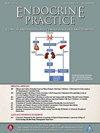在血液病重症监护期间观察到的高频率严重高血糖:一项使用持续葡萄糖监测的前瞻性研究。
IF 3.7
3区 医学
Q2 ENDOCRINOLOGY & METABOLISM
引用次数: 0
摘要
目的:在血液病重症监护期间,患者需要接受大剂量化疗、皮质类固醇、免疫抑制剂和全肠外营养。再加上生理压力以及细胞因子和激素释放的增加,这可能会导致血糖异常,而血糖异常与不良的临床结果有关。本前瞻性研究旨在探讨连续血糖监测(CGM)如何识别血液病重症监护期间的血糖异常:方法:接受嵌合抗原受体(CAR)T细胞疗法、异体或自体干细胞移植(SCT)的患者均符合条件。在整个研究过程中,对60名患者(71%为男性,中位年龄为64岁(IQR[58-68]),10%患有糖尿病)使用CGM和护理点(POC)血糖测量法同时监测血糖水平:93%的患者患有高血糖(血糖>10mmol/L),其中90%的患者没有糖尿病史。严重高血糖(血糖 >13.1mmol/L)患者占 38%。此外,在接受 CAR T 细胞治疗(β=0.19,95% CI=0.04-0.35)和自体 SCT 治疗(β=0.16,95% CI=0.01-0.32)的患者中,高血糖与住院时间延长有关。在检测高血糖(>10 mmol/L:1060 对 124,检测时间提前 2.8 小时(IQR [0.7-4.0]))方面,CGM 优于 POC。CGM与POC之间的平均绝对相对差值为21.5%,99.8%的测量值处于克拉克误差网格的临床可接受A+B区:这些发现强调了使用 CGM 进行血糖监测的潜力和重要性,以改善和提早发现高血糖,这在此类患者中似乎是可行的。我们的研究结果表明,有必要进一步研究 CGM,将其作为优化血糖水平的方法,从而改善接受重症血液病治疗的患者的预后。本文章由计算机程序翻译,如有差异,请以英文原文为准。

High Frequency of Severe Hyperglycemia Observed During Intensive Hematologic Care: A Prospective Study Using Continuous Glucose Monitoring
Objective
During intensive hematologic care, patients are exposed to high-dose chemotherapy, corticosteroids, immunosuppressants, and total parenteral nutrition. Combined with physiologic stress and increased release of cytokines and hormones, this can lead to dysglycemia, which is associated with adverse clinical outcomes. This prospective study aimed to investigate continuous glucose monitoring (CGM) to identify dysglycemia during intensive hematologic care.
Methods
Patients receiving chimeric antigen receptor T-cell therapy or allogeneic or autologous stem cell transplantation were eligible. Throughout the study, glucose levels were concurrently monitored using CGM and point-of-care (POC) glucose measurements in 60 patients (71% male, median age of 64 [interquartile range, 58-68] years, and 10% with diabetes).
Results
Hyperglycemia (glucose level, >10 mmol/L) was prevalent in 93% of patients, of whom 90% had no history of diabetes. Severe hyperglycemia (glucose level, >13.1 mmol/L) was present in 38%. Additionally, hyperglycemia was associated with prolonged hospitalization in patients undergoing chimeric antigen receptor T-cell treatment (β, 0.19; 95% CI, 0.04-0.35) and autologous stem cell transplantation (β, 0.16; 95% CI, 0.01-0.32). CGM outperformed POC in detecting hyperglycemia (>10 mmol/L: 1060 vs 124, detected 2.8 [interquartile range, 0.7-4.0]) hours earlier. The mean absolute relative difference between CGM and POC was 21.5%, with 99.8% of measurements in the clinical acceptable zone A + B of the Clarke error grid.
Conclusion
These findings emphasize the potential and importance of glucose monitoring with CGM for improved and earlier detection of hyperglycemia, in this patient population, which seems feasible. Our results suggest a need for further studies into CGM as method to optimize glucose levels, which could improve outcomes in patients receiving intensive hematologic care.
求助全文
通过发布文献求助,成功后即可免费获取论文全文。
去求助
来源期刊

Endocrine Practice
ENDOCRINOLOGY & METABOLISM-
CiteScore
7.60
自引率
2.40%
发文量
546
审稿时长
41 days
期刊介绍:
Endocrine Practice (ISSN: 1530-891X), a peer-reviewed journal published twelve times a year, is the official journal of the American Association of Clinical Endocrinologists (AACE). The primary mission of Endocrine Practice is to enhance the health care of patients with endocrine diseases through continuing education of practicing endocrinologists.
 求助内容:
求助内容: 应助结果提醒方式:
应助结果提醒方式:


